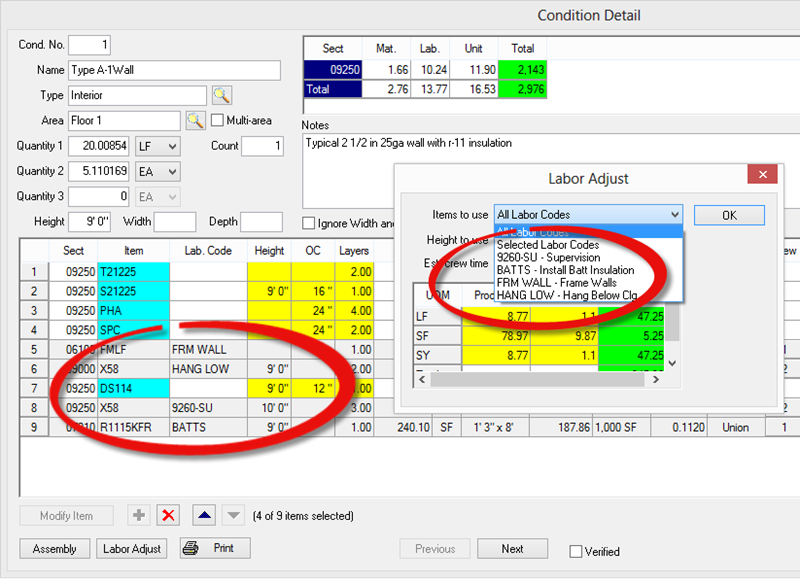Labor (Production) can be adjusted at the Condition Level by clicking the Labor Adjust button at the bottom of the Condition Detail. This opens a dialog box where you can select a specific Labor Cost Code's production, choose "Selected Labor Cost Codes" (rows you've highlighted in the Grid), or choose all Labor Cost Codes used in the Condition. The Labor Adjust feature is intended for use after you've built-out the Condition (added all Items needed).
Adjusting production using the
Condition Labor Adjust dialog does not affect other Conditions in the Bid. To affect
Labor for other Conditions (the entire Bid...), adjust Labor on the
Labor Tab (next article). If you want to adjust a single line Item's production, it is easier to that in the Item
Detail Grid, see the previous article.
In the Condition Detail, click the Labor Adjust button  at the bottom of the Details window.
at the bottom of the Details window.
- If you have a single Item selected in the Item Detail Grid, the Labor Cost Code for that selected Row is selected in Items to use when the dialog box opens.
- If you have more than one Item, but not all Items, highlighted in the Grid when you open the Labor Adjust dialog box, Items to use defaults to "Selected Labor Codes" (shown below).
- If you have all Items that include Labor highlighted in the Grid when you open the Labor Adjust dialog box, Items to use defaults to "All Labor Codes".

In the Labor Adjust dialog, each Labor Cost Code used in the selected line Items is listed (along with options for All Labor Codes and Selected Labor Codes).
Click the drop down to change the Labor Cost Code(s) for which you want to Adjust Labor.

The Labor Adjust dialog box allows an estimator to modify the Labor on more than one Item Detail using a single entry. This feature works differently from adjusting line item labor in the Item Detail Grid. The most important difference is that Labor is factored by the Condition Quantity and not the Labor Item (line item) quantity. This type of calculation allows an estimator to view production for a specific Labor Cost Code that may be tied to one or more materials or labor activities, but more importantly, it provides a mechanism to adjust all the Labor for the entire condition with a single entry.
In the Labor Adjust window, labor is displayed in crew time, production (by UOM), unit price, and total money. These views are controlled by the Items to Use filter and the Height to Use filter.
Modifying one labor value in this dialog updates the others. Time is represented in days and hours. Entering 20 hours is reported as 2 days + 4 hours (based on an 8 hour work day - set on the Bid's Cover Sheet). Both daily and hourly production values are shown simultaneously.
The information displayed is based on time and money. Quick Bid calculates the Total Hours value by adding up the hours of each Labor Item. The Labor Production is then computed by taking the Condition Quantity and dividing it by the Total Hours.
Because of this calculation method, it is recommended that you not use Labor Adjust for single Materials that have more than one layer.
Selecting Codes to Adjust
There are two methods for using the Items to Use filter.
- Modify Labor for one or more Items (that include labor) by simply highlighting the Item(s) in the Condition Item Detail Grid (using the keyboard <Ctrl> and <Shift> keys) then click the Labor Adjust button. Notice Selected Labor Codes displays in the Items to Use filter.
- Modify Labor for the entire Condition - click the Labor Adjust button without highlighting any specific Items. In the Items to Use filter, select All Labor Codes. Now, any adjustments to time, production or money are applied across all Labor Codes in the Condition. These factors will be modified proportionally with the same percentage of change applied to each line item. For example, consider furnishing and installing a door. At the Condition, enter the Material Items, door frame, extra studs, door slab, and hardware. After all Items are entered into the Condition grid, click Labor Adjust, select All Labor Codes and apply three hours. A total of three hours is applied proportionally to each of the Items that have labor associated with them.
The Height to Use filter filters Labor Codes by a specific height - only the filtered codes are adjusted.
